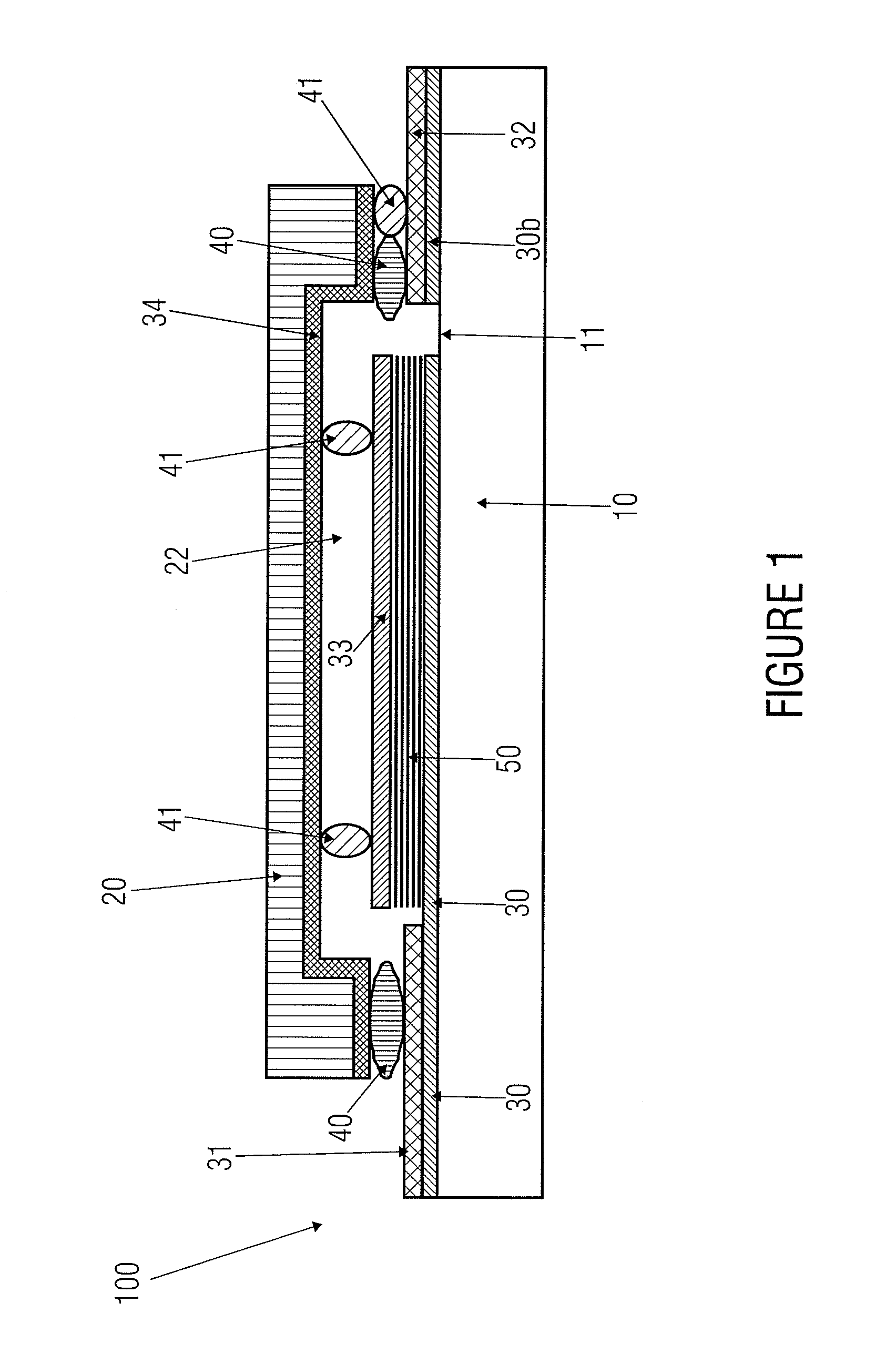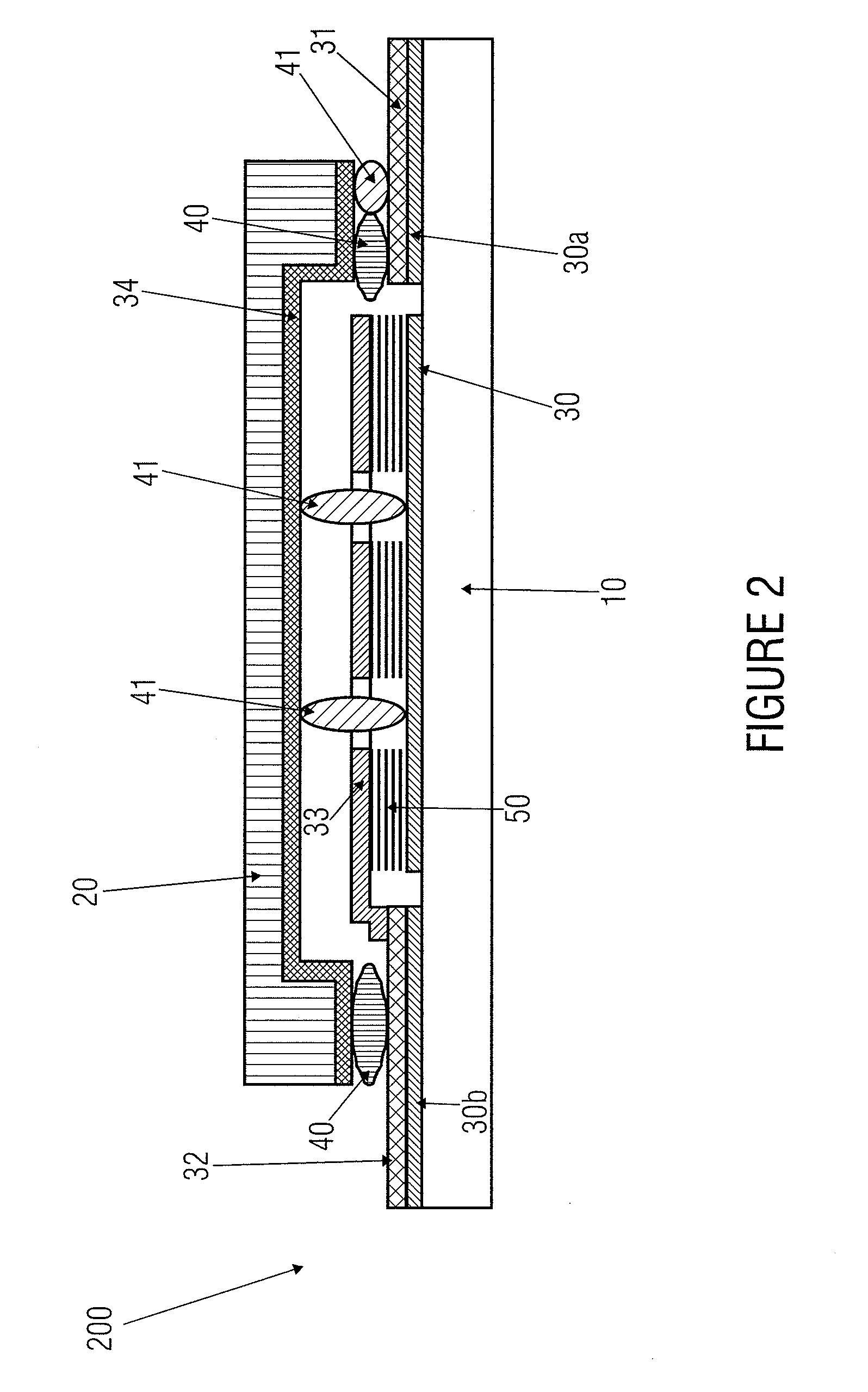Organic Photoelectric Device
a photoelectric device and organic technology, applied in the field of organic photoelectric devices, can solve the problems of reducing the maximum usable device size, limiting the maximum light emitting surface area, and adhesive regions, etc., and achieves the effects of reducing the inactive edge region, reducing the resistance of sheets, and reducing the inactive edge area
- Summary
- Abstract
- Description
- Claims
- Application Information
AI Technical Summary
Benefits of technology
Problems solved by technology
Method used
Image
Examples
first embodiment
[0043]FIG. 1 shows a sectional view of an organic photoelectric device in accordance with the present invention. The organic photoelectric device 100 comprises a substrate 10, which includes a surface 11. The surface 11 has a base electrode 30a as well as an electrically insulated partial base electrode 30b formed thereon. Following this, a roof electrode 33 is formed, so that an organic functional layer 50 is arranged between the roof electrode 33 and the base electrode 30. The lateral extension of the organic functional layer 50 is the same, for example, as the lateral extension of the roof electrode, or deviates only slightly therefrom. The base electrode 30a has a substrate metallization 31 on one of its edges on a surface facing away from the surface 11. On a surface facing away from the surface 11, the partial base electrode 30b has a substrate metallization 32, which corresponds, for example, to the partial base electrode 30b in terms of lateral dimensions, or deviates only s...
second embodiment
[0055]FIG. 2 shows a sectional view of an organic photoelectric device 200 in accordance with the present invention. The organic photoelectric device 200 comprises a substrate 10, which includes a surface 11. The surface 11 has a base electrode 30, a first partial base electrode 30a and a second partial base electrode 30b formed thereon. Following this, a roof electrode 33 is formed, so that an organic functional layer 50 is arranged between the roof electrode 33 and the base electrode 30. The lateral extension of the organic functional layer 50 is the same, for example, as the lateral extension of the roof electrode, or deviates only slightly therefrom. On a surface facing away from the surface 11, the first partial base electrode 30a has a substrate metallization 31, which corresponds, for example, to the first partial base electrode 30a in terms of lateral dimensions, or deviates only slightly from same. On a surface facing away from the surface 11, the second partial base electr...
third embodiment
[0059]FIG. 3 shows a sectional view of an organic photoelectric device 300 in accordance with the present invention. The organic photoelectric device 300 shown in FIG. 3 differs from the organic photoelectric device 100 shown in FIG. 1 in that, instead of a glass provided with cavities 22, a planar no-cavity glass substrate is used as the cover glass 20. Instead of producing the depressions or cavities in a subtractive manner by means of etching, an encapsulation edge is created on the edges of the cover glass 20 by means of a glass frit paste fused in a structured manner, which glass frit paste implements the distance—useful for the active layers and / or the organic functional layer 50 and for the accommodation of getter materials—between the coated substrate 100 and the cover glass substrate, or cover glass 20.
PUM
 Login to View More
Login to View More Abstract
Description
Claims
Application Information
 Login to View More
Login to View More - R&D
- Intellectual Property
- Life Sciences
- Materials
- Tech Scout
- Unparalleled Data Quality
- Higher Quality Content
- 60% Fewer Hallucinations
Browse by: Latest US Patents, China's latest patents, Technical Efficacy Thesaurus, Application Domain, Technology Topic, Popular Technical Reports.
© 2025 PatSnap. All rights reserved.Legal|Privacy policy|Modern Slavery Act Transparency Statement|Sitemap|About US| Contact US: help@patsnap.com



